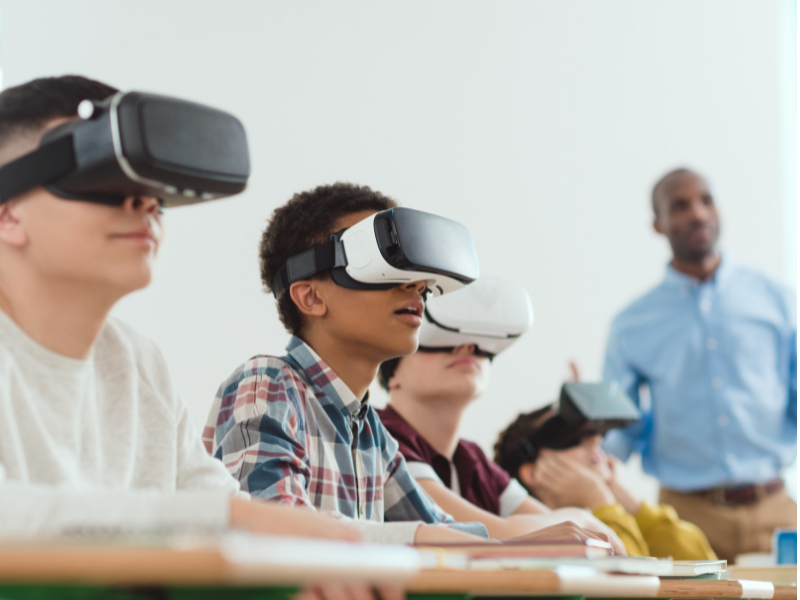
No longer just for gamers, VR is also becoming progressively more widespread, for example with uses in medicine, to give an interactive visualisation of the human body, or to provide employee training in a safe and scalable way, without the risk of the employees getting hurt or accidents occurring. Now, VR is beginning to find its place in reimagining education.
A team from Singapore Management University has been researching how virtual reality, or VR, can be used in teaching undergraduate university students’ key concepts in computing.
Read the original article: https://ink.library.smu.edu.sg/sis_research/7586/
Transcript:
Hello and welcome to Research Pod! Thank you for listening and joining us today.
In this episode, we’ll discuss the work of Associate Professor Kyong Jin Shim, together with her student Shawn Pang, and colleagues Yi Meng Lau and Associate Professor Swapna Gottipati from Singapore Management University. This team has been researching how virtual reality, or VR, can be used in teaching undergraduate university students’ key concepts in computing.
We increasingly live in and access resources in the virtual world, and how users interact in the virtual world is always changing. VR offers an experience where the user is immersed in a simulated world, allowing them to interact with and explore their new surroundings. They can connect with users all over the world without having to leave the house. No longer just for gamers, VR is also becoming progressively more widespread, for example with uses in medicine, to give an interactive visualisation of the human body, or to provide employee training in a safe and scalable way, without the risk of the employees getting hurt or accidents occurring. Now, VR is beginning to find its place in reimagining education.
The research team believes that VR technology can also be applied in the field of computing, where concepts can be abstract and hard to visualise or understand. To help students studying computing or similar subjects at a university level, the team have created a virtual reality environment called ‘VR Computing Lab’ to aid them in getting to grips with abstract computing concepts. With VR Computing Lab, not only can students interact with these concepts and engage with tailored practice activities and tutorials, but they can engage with the environment built by the team. Through interacting with their peers and instructors, they can choose how to engage with the activities and build confidence and competence in their skills. Whilst some previous work has been carried out in this area, the use of VR in university level education is still in its early stages. The team looked to build on this through improving the graphics, increasing interactivity and ensuring the students receive feedback throughout their experience in the virtual environment.
To construct their VR environment, the team considered using different VR platforms as a basis to build their computing lab and they chose to use a platform called VRChat, an already established social VR platform. It was chosen as it is more inclusive for students - it doesn’t require a powerful PC to run, and a VR headset is optional for this environment. To develop the interactive content, the team use Unity, a resource for programming games. The graphics are built using Blender, a tool which allows for images and models to be drawn and rendered in three dimensions.
Within their VR Computing Lab, the team look at how they can support students through considering the Self Determination Theory framework. This framework encompasses how, by supporting the psychological needs of the learner, the learner will have their own motivation to complete tasks to satisfy their own interests or for their own enjoyment. To facilitate this motivation, the framework focuses on three psychological needs – autonomy, competence and relatedness - and the researchers find ways to incorporate these into their VR environment.
A sense of autonomy or feeling like you are in control of your own actions is brought into VR Computing Lab through the use of stations that the learner can visit to complete tasks. The student is allowed autonomy in the ability to customise their avatar and roam around the VR world freely, as well as being able to choose which stations to visit and what tasks they would like to carry out, for example picking between learning or practising a particular topic. This allows students to feel like they’re in control of their work and can lead to higher levels of commitment towards learning.
Within the different learning activities, students in VR Computing Lab can build competence in their subject. The lesson stations provide a way for students to get hints when they are struggling with a question and to receive feedback when they’re wrong, as well as allowing them to continually track their progress. Moreover, the environment can track the student’s skill level to ensure they are given questions that are challenging enough so that they remain engaged, but not so difficult that they are overwhelmed. During the tutorial section of lessons, the stations can track the skill of a student, and then the practice questions can be adjusted accordingly. This helps the learner to continually built their competence in the topic.
VR Computing Lab uses multiplayer aspects to allow students to feel a sense of connection. The virtual environment is designed to facilitate this, with group seating areas and a stage area for seminars alongside the learning stations. This allows students to use VR Computing Lab as a space to learn together in different ways, from a large group lab session to smaller group discussions. Students are also able to use it as a social space. As the VR environment is always online, students can join whenever they like, both to learn and to socialise. The design creates a modern co-working style space, with different types of seating and green elements like plants, as opposed to the typical lecture theatre. This adds the element of relatedness to VR Computing Lab, allowing students to feel comfortable around their peers and that they belong in this environment.
With the psychological needs of the students catered for through considering relatedness, competence and autonomy in the Self Determination Theory framework, the researchers look at how to incorporate the learning stations into the environment. Each station has a ‘Learn Mode’ to introduce the concept to the student, and a ‘Practice Mode’ where the student engages in challenges by interacting with objects in the VR environment using their controller.
For example, the researchers made a learning session focusing on Linked Lists, a topic from a university Data Structures and Algorithms course, studied by Information Systems and Computer Science students. To provide a visual aid for students studying this topic, they are presented with a song playlist. Like in the playlists they might encounter on an everyday basis, they have an ‘Up Next’ field which says which song is next on the playlist. The student can then rearrange the playlist and reflect on how this is mirrored in the code using a code panel. The learner can interact with all the elements of the station, as well as being able to make their own annotations on the lesson materials.
To test out the VR Computing Lab, the team held a focus group of 6 undergraduate students who had previously completed the Data Structures and Algorithms course. These students each spent an hour in the virtual environment with guidance on how to use the VR equipment and verbal assistance whilst they were in the environment, and the researchers collected their feedback.
The focus group appreciated the visualisations of the concept in the linked lists lesson and preferred it to the usual slideshow presentation they would have received in a regular classroom. They also enjoyed the feeling of progression as they worked through the practice activities of increasing difficulty, and the sense of achievement that comes with completing a station. Finally, they liked the appearance of the virtual environment and mentioned wanting to return and use it as a social space. The students also suggested some modifications, such as giving a visual cue or sound to indicate if a task is completed correctly. Overall, the positive feedback received from the students related to the sense of autonomy, relatedness and competence – which were exactly what the team was trying to create, hence it in turn suggests that students’ psychological needs are being met through the VR Computing Lab.
In closing, the researchers shared that
“The goal of VR Computing Lab is to support the psychological needs of students in a virtual environment with all the elements presented, in hopes of facilitating their intrinsic motivation and motivation to learn computing concepts in an engaging and authentic way that is self-driven.”
Through this project, the researchers built a VR Computing Lab where using the Self-Determination Theory, they were able to design the Lab to meet the psychological needs of students. Within their VR environment, students could connect and learn from different locations, access the lab at any time, and were given autonomy to use the environment as they choose. Students were able to complete lessons designed to help them visualise tricky concepts and practised them with custom tasks adapted to their skill level, building competence in the topic. The co-working style design and different areas of VR Computing Lab also allowed for social interactions and developed a sense of belonging for the students.
That’s all for this episode, thanks for listening. You can find the paper on VR Computing Lab in the show notes for this episode and, as ever, be sure to subscribe to ResearchPod to hear more of the latest science news.
See you again soon.
Also published on: https://researchpod.org/education-training/virtual-reality-classroom-creating-vr-computing-lab
Podcast is also available on Spotify, Apple iTunes, Google Podcasts, and many more (please use search term “ResearchPod”).
See More News
Want to see more of SMU Research?
Sign up for Research@SMU e-newslettter to know more about our research and research-related events!
If you would like to remove yourself from all our mailing list, please visit https://eservices.smu.edu.sg/internet/DNC/Default.aspx

